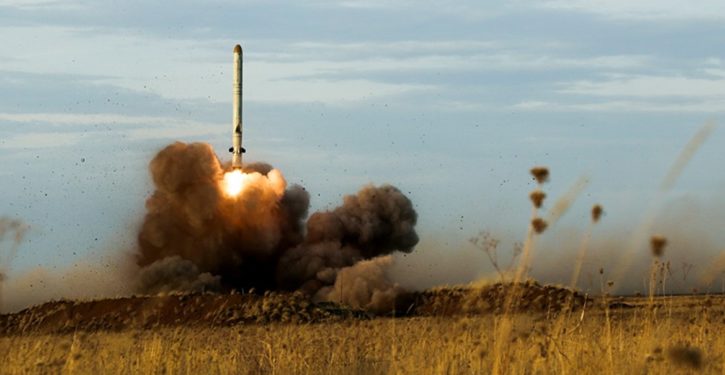
The timing is odd for the disclosure to the New York Times on Tuesday that Russia has operationally deployed a battalion of ground-launched cruise missiles (GLCM), whose capabilities violate the terms of the 1987 INF Treaty. So is the manner of disclosure: through an anonymous leak, rather than a formal announcement.
The unit is one of two battalions thought to be operational today; the other is at the military complex in Kapustin Yar (see map below), where Russia tests missiles as well as rockets for the Russian space program. The deployment is said to have occurred in December 2016.
If the news were that Russia has deployed the battalion to the border of Eastern Europe, the reason for disclosing it would be obvious. (It’s also a really good bet we would have been told that outright, rather than being left in suspense.) But although that originally seemed to be the implication, that’s not what the report says. The unnamed U.S. officials cited in the report didn’t state where the battalion was deployed.
Will this presidential election be the most important in American history?
In fact, NYT’s single reference to a possible operational deployment site alludes to unconfirmed reports that GLCMs may be deployed to a location in central Russia (i.e., Central Asia).
That could mean somewhere close to Kapustin Yar. But that wouldn’t be particularly meaningful, since there’s already an operational battalion in Kapustin Yar. A battalion in Kapustin Yar can threaten parts of Eastern Europe.
Or, it could mean that the deployed battalion is now fielded further east – which would quickly put it out of range of NATO nations.
It’s already been well hashed out that developing and possessing these missiles – which are presumed to be the missiles NATO designates the SSC-8 – violates the INF Treaty. That point isn’t new. It’s an important point, and should certainly be addressed as a national security matter, but it’s not clear why we seem to be being baited to get anxious about it, without a formal statement of U.S. intentions or policy – or even of what we know.
This disclosure doesn’t look like something the Trump administration made deliberately. It doesn’t fit a deliberate profile. Perhaps most importantly, it doesn’t sound like the disclosure of someone who has to think systematically about the meaning of this data point for U.S. policy. At the very least, it’s not the disclosure of someone who has.
We do know, as NYT mentions, that the SSC-8’s detectable deployment footprint may be indistinguishable from the Iskander-M, the short-range missile system that is deployed at Luga, in western Russia, and in the Baltic Russian enclave of Kaliningrad. But we’ve known that for some time. In the absence of fresh statements about U.S. policy on the matter, putting out a new, vague data point merely serves to raise alarm in a sort of open-ended way.
Bait or not, there’s more here than meets the eye
Here are a few points to use as thinking aids. Again, I stress that developing and possessing this missile system violates the INF Treaty. These points are not an excuse for Russia. They do suggest that there are reasons now why Russia considers the INF Treaty an increasingly unrealistic form of restraint. Everything isn’t about the Russian line of confrontation with NATO.
The Russians shouldn’t violate the treaty, of course; they should seek to renegotiate it, or – failing that – formally abrogate it. Their policy should be open and aboveboard.
But their policy is not required to be one-dimensional, or to ignore the changes of the last 30 years. Conditions in Russia’s neighborhood have changed since the INF Treaty was signed in December 1987. Russia has been an agent of some of that change, and not in a good way. But Russia also has legitimate security concerns, and changes that have been thrust on her.
The treaty eliminated two major categories of missiles for the U.S. and (then) USSR: ground-launched short- and intermediate-range ballistic missiles, and ground-launched cruise missiles, with ranges of between 500 km and 5,500 km. (Air- and sea-launched cruise missiles were not eliminated; both countries still have them.)
In 1987, the nexus of the threat posed by those weapons was located in Europe. There was no other geographic nexus in which countervailing threats from those weapon systems was a factor.
In 2017, that is no longer the case. In fact, the U.S. should be taking greater account than we are today of the potential threat from intermediate-range missiles that could be deployed in Central America (see here as well). But it’s Russia that lives in the more unstable and missile-infested neighborhood.
None of China, Pakistan, or Iran is bound by an agreement like the INF Treaty, and all of them can reach Russia today with their missile arsenals. (China can reach Russia with a very large air force as well.) In an unstable nation like Afghanistan, or potentially parts of Pakistan, radical elements like ISIS or the Taliban could get into power and move or use weapon systems that are not a threat at the moment. (India has the missiles, of course, but is so unlikely to make war on Russia, or be taken over by radicals, that she does not merit inclusion here. North Korea has missiles as well, but has long been a client of Moscow, and would not in any realistic scenario become a direct threat to Russia. That said, Pyongyang could certainly create larger problems that made Russia less secure.)
To be sure, Russia is also a threat to her neighbors, and likes to hold a whip-hand over them. Ukraine, Georgia, and some of the Stans can speak eloquently on that topic. (Belarus might be more reticent, but could say many of the same things.)
That feature of the political problem is Russia-directed; there’s more than one dimension here. Russia calls every move “defensive,” as most nations do most of the time – but her neighbors would often disagree. Some of what Russia envisions in her “near abroad” now is a new exploitation of technology and military operating space: strategic moves that are not strictly necessary for defense, but that Russia is making because, with emerging capabilities, she can, and doing so gives her a relative advantage for multiple purposes, including political and economic ones. (See here, for example.)
But the bottom line in this narrative is that since 1987, the geo-military significance of intermediate range missiles has changed in Asia, for political reasons. And Russia can’t ignore that.
At the interface of Europe with Russia, it is still valid to insist that neither side has a compelling need for intermediate range missiles to shore up defensive positions. The rationale of the INF Treaty still obtains.
Along Russia’s Asian perimeter, on the other hand, it is not unreasonable for Moscow to take a different view.
So if the Russians have deployed a GLCM battalion to Central Asia, that is of concern as an INF Treaty matter, but it is not a new threat to Europe. It’s something Russia can do, without having in mind a threat to Europe. Whether or not Russia does have such a mindset of geopolitical separation, the point is that having it is a reasonable proposition.
To the maps
A series of geographic depictions illustrates what I’ve just described. Here is the threat the SSC-8 would pose to Europe, if deployed near St. Petersburg in furthest western Russia. Also depicted is the range from the battalion at Kapustin Yar.

Next is the same threat range from a battalion deployed in the Russian Central Military District (which is where Russian sources have suggested that the first operational battalion was deployed. The Russian military districts are depicted first, for orientation). The first threat-ring map shows a battalion deployed on the western edge of the Central Military District, near the battalion at Kapustin Yar. The second shows a battalion deployed on the far eastern edge of the Central Military District.



Now, shift gears. Here is what the U.S. can do by parking sea-launched Tomahawk missiles – which are not prohibited by the INF Treaty – off of the coastlines of Europe and Asia.

Doing this for the purposes of either combat or credible intimidation requires maritime superiority – which the U.S. maintained indisputably between 1987 and about 2013. That’s important; keep it in mind as we look at Russia’s view in a moment.
In 1987, Russia (then the Soviet Union) accepted being at this particular disadvantage vis-à-vis the U.S. This was done knowingly; the Soviet Russians had sought for some time to put sea-launched cruise missiles up for arms negotiation. The U.S. refused to put them on the block, and ultimately, the Soviets agreed to the INF Treaty without imposing limits on other cruise missiles.
Of course, Russia can still put her own cruise missiles on mobile platforms and threaten North America with them. (She practices that regularly with the Tu-95 Bear bomber flights against North America. Her seaborne cruise missile threat, against distant target nations, is posed almost entirely with submarines today.)
But North America isn’t the only geographic location where Russia wants (or, from the Russian perspective, needs) to be able to pose a threat. Neither is Europe.
And the geographic reality of the other locations is a different one. This is the final map, showing that in Asia, Russia’s military thinking is – and must be – driven by her very long land borders, which are interfaces of threat calculus and operational planning.

To maintain, with offshore assets, a persistent, credible threat for intimidation or combat, Russia requires something she has never had: maritime superiority, and a sufficient order of battle to bring the threat wherever she needs to from the sea. Russia also has a constraint the U.S. would not have in an expeditionary operation against the Eurasian land mass. Russia must hold her own territory, and dominate the territory between there and the location of the fight.
The map above is a notional depiction of how Russia might use the relevant cruise missile assets. It’s not a depiction of how she can. The U.S. is by no means Russia’s only problem, in the offshore launch areas for cruise missiles. Russia is very aware that well-armed, capable nations like Japan, South Korea, Australia, and much of NATO Europe could thwart Russian access to offshore launch areas for a fight in the Eurasian theater. The Black and Caspian Seas are geographically advantageous, but Russia can’t guarantee full dominance of either in an Asian conflict.
For Russia, the ability to mount a multidimensional military threat in Asia, from Russian territory, is essential. The day basically had to come when Russia would find the INF Treaty too confining for the totality of her geo-military requirements. Intermediate range ground-launched missiles (ballistic or cruise) make too much sense in Asia, for Russia to accept being the only major power without them.
Summary
As a matter of Moscow’s reputation and good faith, we must always take into account how the Russians honor treaties, or don’t. And there are still valid security principles encapsulated in the INF Treaty.
But Russia’s Asian neighbors haven’t committed to those principles, as America did in 1987. In 2017, Russia can’t be expected to behave as if they have.
Has Russia put an SSC-8 battalion in western Russia? We haven’t been told so, but that would be something to go to GQ over. Otherwise, what we have on 15 February 2017 is the same evolving, complex problem we had on 13 February 2017. It’s not clear who chose 14 February 2017 to bring up a one-dimensional slice of it in the New York Times – or why.




